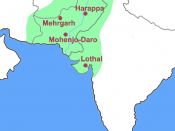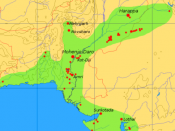Ancient civilizations have taught and passed on knowledge to following civilizations and have given us insight to what life was and how life was thousands of years ago. Two very similar yet different cultures are the Assyrians, which were a part of the Mesopotamian civilization, and the Indus Valley civilization. Mesopotamia stands for the "land between rivers" in Greek (The British Museum). The Indus Valley Civilization also existed about the same time period and flourished along the Indus River. In this paper, I will compare similarities and differences between the Mesopotamian and Indus Valley civilizations and also relate how both cultures influenced our cultures today.
Mesopotamian is a general term for Sumer, Akkadian, Babylonian, and Assyrian empires. Mesopotamians created many city-states along the Tigris and Euphrates rivers. Specialized labor and agriculture, aided by irrigation and flood control systems, helped this civilization survive. The Assyrians were warriors who defeated Babylonians, Hittites, and Elamites.
Much of the Assyrian architecture, statues, murals, and sculptures depicted the cultures warring ways. Ethnic differences can be seen in Assyrian art as the physical appearances of enemies appear different than that of the Assyrians. The palace walls were covered with stone slabs and carved with images of court rituals, hunting, and war. Moreover, texts were found next to reliefs which were used to identify specific people who were important. People were also depicted by standardized clothing and headgear rather than their physical form (Bahrani 48-59). The Indus Valley civilization was a large civilization which extended over 400,000 km2 The Indus Valley civilization established itself along the Saraswati and Indus River (Lal 6). The cities were well planned along with well established farming villages. The Indus Valley civilization also had a standardization of weights and measures which portrayed "impressive administrative and economic discipline." This complexity helped...



LOVED IT
this essay is really good...it helped me so much
xxx
0 out of 0 people found this comment useful.